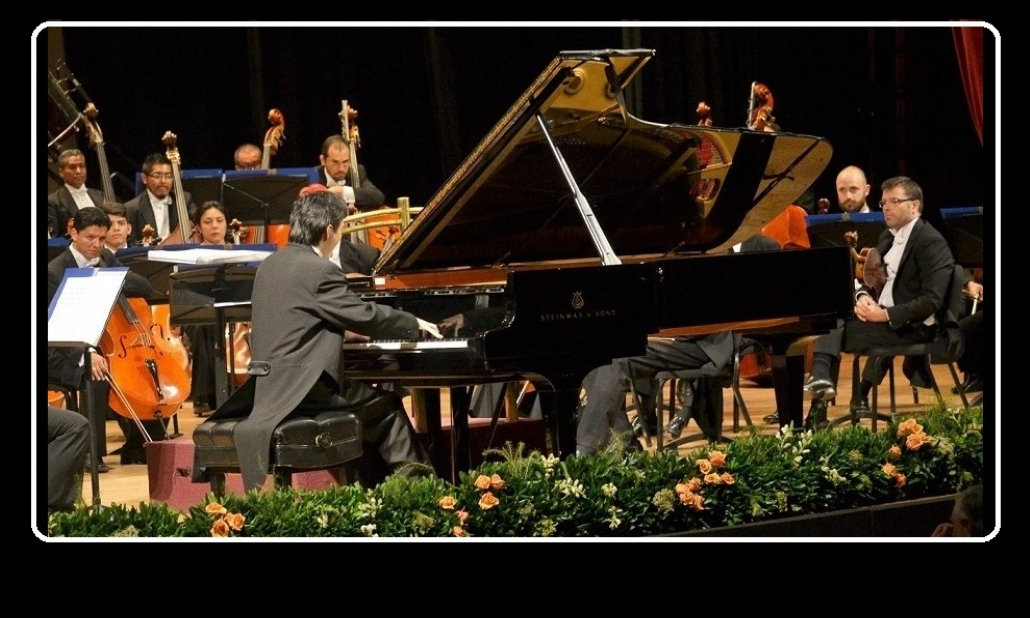Copyright (C) 1999-2022 Hilldale Media Network All Rights Reserved.


American concert: an extraordinary success of the Bogotá Philharmonic
18th, November 2019
Montero's work, played on the piano by pianist Sheng Cai, showed us a new orchestral formation made up solely of the strings. The sound, dynamics, and balance relative to the soloist were exceptional... The crystalline and prolific soloist offered a heartfelt interpretation of this work, clearly influenced by tango and the popular airs of Argentina. The first movement slightly recalls the impressionist style, with a series of colorful and intense scales in the piano part and an accompaniment that walks through different atmospheres, dynamics and nuances. The last movement, more influenced by the rhythms of tango in its accentuation and syncopation, was much more energetic and virtuous for the soloist.
***** Five Stars, - by critic Irene Littfack, Bachtrack
Any pianist who has mastered Liszt’s Transcendental Etudes and is ready to record them must be admired. He or she must not only have a transcendental technique but also bring out the character and expressive content of the pieces, which are excellent musical tone poems. In both of these new releases the artist rise splendidly to this challenge. The young Chinese-Canadian pianist Sheng Cai is impressive with the Liszt etudes. He is not quite as powerful as Scherbakov but plays with great clarity and delicacy (when appropriate) ..., it's a fine recording that I enjoyed listening to.
- Alexander Repp, the American Record Guide September/October issue 2019
September 2019
Sheng Cai's Liszt album
In the Toccata, Cai’s tempo (6:51) feels natural, and the myriad notes Schumann writes in his score are all there.
Cai regains his footing in the Humoreske. While not as technically demanding as the Toccata, the Humoreske’s hair-trigger mood changes make it an extremely challenging work to sustain. Cai successfully manages Schumann’s narrative complexities, and is equally at home in the virtuoso passages and the score’s lyrical respites. Perhaps some of the transitions between Schumann’s myriad mood shifts could be better internalized, but that is a comment that applies to most recordings of this work. And while it is not likely to replace by longtime favorites—Richter, Vladimir Horowitz, Radu Lupu, and Piotr Anderszewski—I thoroughly enjoyed Cai’s version.
Perhaps surprisingly, the Arabesque is the real gem of the recital. This is a heart-felt performance and an unqualified success. After hearing it, I frankly wish Cai had chosen to record the Blumenstück instead of the Toccata. The Carnaval is equally satisfying, and while Cai’s outgoing personality appears to me to be closer to Florestan, some of the most persuasive playing happens in the sections that make relatively modest demands of the performer, most notably the two waltzes.
The quality of the engineering is solid, but generally favors the treble. A stronger bass might have been advisable. In sum, a fine introduction to a pianist whose career deserves attention.
---Radu A. Lelutiu,critic Fanfare, USA
Cai regains his footing in the Humoreske. While not as technically demanding as the Toccata, the Humoreske’s hair-trigger mood changes make it an extremely challenging work to sustain. Cai successfully manages Schumann’s narrative complexities, and is equally at home in the virtuoso passages and the score’s lyrical respites. Perhaps some of the transitions between Schumann’s myriad mood shifts could be better internalized, but that is a comment that applies to most recordings of this work. And while it is not likely to replace by longtime favorites—Richter, Vladimir Horowitz, Radu Lupu, and Piotr Anderszewski—I thoroughly enjoyed Cai’s version.
Perhaps surprisingly, the Arabesque is the real gem of the recital. This is a heart-felt performance and an unqualified success. After hearing it, I frankly wish Cai had chosen to record the Blumenstück instead of the Toccata. The Carnaval is equally satisfying, and while Cai’s outgoing personality appears to me to be closer to Florestan, some of the most persuasive playing happens in the sections that make relatively modest demands of the performer, most notably the two waltzes.
The quality of the engineering is solid, but generally favors the treble. A stronger bass might have been advisable. In sum, a fine introduction to a pianist whose career deserves attention.
---Radu A. Lelutiu,critic Fanfare, USA
Sheng Cai's Schumann Album